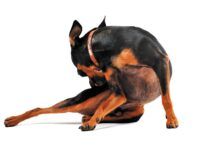Sniffing out illness in another dog?
Q: Are there any dogs that can sniff out cancer in other dogs? My chow chow initiates play with my golden retriever by nipping at his back leg and then backing off. Last year the golden had a small area of missing hair on his back leg, and the vet looked at it during his yearly exam. There was no broken skin, and the doctor didn’t see any cut or foreign object. The vet said that whatever it was, it had already healed and I didn’t need to do anything for the patch of missing hair. He suggested I might put a cone on the chow chow so she couldn’t get to him.
Red Eye
Q: My dog’s left eye has been red for several days. Is this something to be concerned about, or will it go away on its own?
Bridging the Communication Gap
If only we could translate our dogs’ communications with more precision so we could better tend to their physical and emotional needs. It’s coming.
Excessive Licking in the Summer Could Indicate a Hot Spot
The weather is warm, and the air is moist—like right now in many parts of the country—and your dog has started excessively grooming her hind quarters. In fact, she may have been licking, biting, and chewing to the point that she has taken off hair and maybe even some skin, leaving a raw, red area—a hot spot. Worse still, the spot may look inflamed, ooze pus, and bleed intermittently.
You Want to Rent the Apartment, But the Lease Says ‘No Pets Allowed’
You’ve found a wonderful place to live, and though the lease says “No pets allowed,” you’ve been back to the apartment building a few times and have seen another renter walking their dog on the grounds. You’ve even seen a dog in a window, so you figure it won’t be a problem—kind of like the dog owner’s equivalent of jaywalking. But it very well could.
Download The Full August 2024 Issue PDF
- For How Long Can a Dog Food Be “New” and “Improved”?
- Short Takes
- At What Age Should Your Dog Be Spayed or Neutered? It’s Complicated.
- When Your Dog Smells Bad—No, Really Bad
- Can You Take Your Dog on a Cruise?
- Beware of Sand Impaction When Taking Your Dog to the Beach
- Would Chasing a Laser Beam Be a Good Kind of Activity for Your Dog?
- Dear Doctor
For How Long Can a Dog Food Be “New” and “Improved”?
Have you ever seen the words “new” or “improved” on a dog food label? If so, it shouldn’t be there for more than the first six months of production. “It’s not new forever,” says the Association of American Feed Control Officials (AAFCO), whose guidelines are generally written into law by each state legislature.
On the Horizon: Dog Cancer Screening Via a Urine Sample
The molecules in a dog’s urine have a unique fingerprint, and researchers are finding that it can be used to detect—in minutes—whether a dog has cancer. There are blood tests for canine cancer, but they can be expensive, and you have to wait for a lab to come back with the results. Moreover, the results might be only about 60 percent accurate. With a urine test, researchers are finding results that are more than 90 percent accurate.
When $35 of Prevention is Worth More than $10,000 of Cure
Inoculation against a bacterial disease called leptospirosis is not considered a core vaccine, meaning you should discuss with your vet whether your particular dog is at risk. The offending bacteria particularly thrive in relatively warm climates with high average rainfall.
At What Age Should Your Dog Be Spayed or Neutered? It’s Complicated.
A female wire-haired pointer, the tenth most popular dog breed, has only a 1 percent chance of getting cancer. But if she is spayed before she is a year old, her risk for cancer of the lymph nodes shoots up to more than 10 percent. A male mastiff has a 6 percent chance of developing a joint disorder, but that risk rises to 21 percent if he is castrated before he is one.
When Your Dog Smells Bad—No, Really Bad
Dogs seem happiest when they stink. Who among us hasn’t had—or at least seen—a dog happily rolling her body back and forth over something positively rank?
Can You Take Your Dog on a Cruise?
Love going on vacation but hate leaving your dog at home? What about taking your pet on a cruise?
















